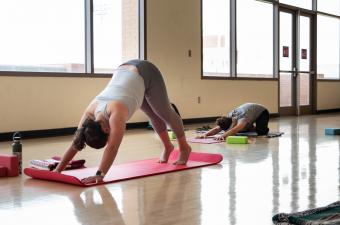Meditation Spotlight: Mindful Breathing
Have you heard of meditation but are not sure on where to start? Maybe you’ve tried it before but didn’t have the success you were looking for. Read on for some tips and recommendations on starting your own meditation routine as well as a suggested meditation you can practice anywhere!
Meditation has become a trending topic in recent years, but why meditate? Meditation offers a wealth of benefits that can be a game-changer for your routine, especially for busy students. Some of the benefits include: stress reduction, anxiety relief, improvements in emotional well-being, and lengthening of the attention span, among many other proven benefits. All of these benefits help manage the chaos of the semester, and can help well beyond our school years.
When you think of meditation, often what comes to mind is a serene looking person sitting for hours, completely calm and focused. The person makes it look effortless in our mind. While this can be a goal, real meditation, especially at the beginning, does not always look like this. It usually looks like a person sitting for a few minutes at a time, focusing on something. The mind will drift from your focus point to other topics, but the goal is to redirect your attention back to whatever you are focusing on.
In this meditation spotlight, the focus is the breath, also called mindful breathing.
Mindful breathing gives all of the benefits of meditation, plus it encourages mindful breathing outside of the meditation practice which can help you keep your cool in situations that would be difficult to deal with otherwise.
How do you practice mindful breathing meditation?
It all starts with paying attention to your breath, feeling the air come into your lungs as you inhale and experiencing your breath expel as you exhale.
When you’re ready to practice, you’ll want to be seated and comfortable. You can keep your eyes open if you prefer, but you might find it easier to focus with your eyes closed. A timer will be helpful as well. In the beginning, we recommend setting your timer for 5 minutes and extending the time as you feel more comfortable with the meditation. The more you practice the easier it will be to meditate longer.
Once you are situated, bring your focus to your breath. Feel the quality of the air as you inhale, feel the texture of the breath as you exhale. Continue this for 5 or more minutes. As your mind begins to drift to another thought or topic, gently bring your attention back to the breath.
Here are some tips to keep in mind as you are practicing:
- Stay in a comfortable, relaxed position. This could be in a chair, the floor with a cushion, a bed, the couch, whatever you have available and are the most comfortable on. You’ll want to keep a straight back while practicing, but don’t hold it so tight that you are uncomfortable.
- Notice your body. Feel the fullness of your body, feel its shape and weight. Feel the spots of tension within the body and send your breath to those places to help release and relax the tension. Become curious about your body: the touch it feels, the sensations it experiences, the connection with your seat.
- Experience the flow of the breath. Become absorbed in your breath, feeling the inhale and the exhale flow. Don’t feel any need to lengthen or hold your breath, just allow it to flow effortlessly and naturally. Notice where your breath goes within the body. It could be your chest, your belly, throat or your nose. Experience the sensations of the breath as it flows through you.
- Be patient with your wandering mind. While you are practicing meditation, you’ll notice that your mind may wander. This is not a sign that you’re doing it wrong—actually, quite the opposite. It is totally normal. As other thoughts arise in the mind, notice those thoughts and acknowledge them, and then gently redirect your focus back to your breath. The more you practice, the easier it will be to keep your attention on your breath.
